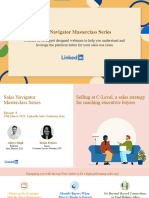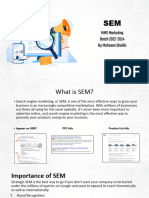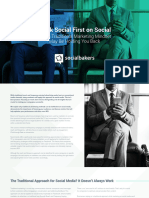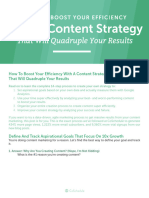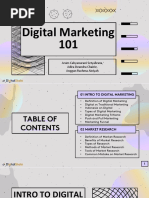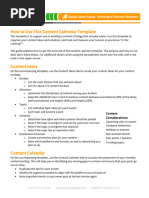Conversion Rate Optimization QuickStart Guide
Uploaded by
herryaptConversion Rate Optimization QuickStart Guide
Uploaded by
herryaptConversion Rates
What is a Conversion?
A conversion is an action that you want someone to take online. A conversion could be defined as
making a purchase, but it could also be signing up for an email, downloading online content or watching
a video. Many businesses have multiple conversions that they track based on their business objectives.
Macro-conversions:
• Purchasing a product from the site
• Requesting a quote
• Subscribing to a service
Micro-conversions:
• Signing up for email lists
• Creating an account
• Adding a product to the cart
Be sure to consider the entire marketing funnel when choosing
conversions. While it may seem easy to focus on bottom of the
funnel conversions (sales, contact forms) it is also important to
look for conversion opportunities for the top of the funnel.
NOTE: You can set anything as a conversion. It is helpful to set conversions that are linked to your
business objectives.
What is Conversion Rate Optimization?
Conversion rate optimization is focused on increasing the percentage of people who convert or take
action on your website.
The conversion rate is the percent of people who took the action or the “conversion”. For example, if 100
people visited my website and 5 of them purchased, my conversion rate would be 5% (5/100).
Conversion rate optimization focuses on taking steps to increase the number of people who convert. This
is usually achieved by improving a number of elements on the site to increase the conversion rate. For
example, changing the site design, adjusting the offer, etc.
3 Elements of Conversion Optimization: SAC
1. Source
The first thing to consider is the source of the traffic. How did the person arrive at the site? What
are their goals and expectations? At this stage it is helpful to consider the different stages of the
funnel that your audience may be in based on how they arrived at the website.
© Boot Camp Digital • www.BootCampDigital.com • info@BootCampDigital.com
Conversion Rates
NOTE: Get as specific as possible in defining your audience. Consider their behaviors and
interests and create personas to understand them as complete people. If you aren’t sure, use data
to inform your ideas from your website, social networks or other research.
2. Action
What is the action that you want them to take? What is the next step for them to move forward in
the process to do business with you? It is important to consider different actions or conversions
for different traffic sources or people in different stages of the buying funnel.
NOTE: Make sure that your Call to Action (CTA) is strong and uses best practices to encourage
conversion. A strong call to action should stand out and it should be evident to a user what the
next step is.
3. Convince
How do you convince or persuade them to take the action? What do they need to understand,
believe or feel in order to confidently take the next step? It is important to make sure that you
offer the user value to convince them to take the next step. Be sure that your call-to-action has a
clear and compelling value proposition for the user.
NOTE: To convince someone to take action you should be sure that your offer is relevant and has
a clear value proposition. Relevancy means that the copy is specifically relevant to the audience
based on how they came to your site.
Aligning SAC
To maximize conversions it is important that the source of traffic, the desired action and the technique
used to convince a user are all aligned. This is referred to as scent – the same way an animal tracks scent
to find its prey, humans look for consistency across channels.
This means that the approach used to source the traffic should be consistent with all of the elements of
the website. For example, if your ad says “Click to get a free trial” the landing page should have a clear
“Free Trial” action button and the copy and design should convince someone to take the trial. Sending
them to a homepage without a clear offer would show misalignment between the Source, the Action and
the Convincing.
The stronger the link between the elements of SAC the more likely a site is to drive conversions. This
means that improving conversions isn’t only about landing page optimization or usability improvement.
It involves looking strategically at the elements of scent.
NOTE: This involves linking social media, digital advertising, email marketing and any other
method used to attract people to the site. To optimize conversions all elements of the marketing
must align – the email offer must match the action on the website and convince someone to act.
© Boot Camp Digital • www.BootCampDigital.com • info@BootCampDigital.com
Conversion Rates
Principles of Influence in Driving Conversions
As you build your execution and test different ways to convince
people to take action, consider harnessing the 7 principles of
Influence from Robert Cialdini. These principles represent the
most common strategies that can be used to drive someone to
take action based on psychology.
In creating your call to action and convincing people to take
action, consider how you can incorporate one or more of the
principles of influence in to your approach. These proven
principles are a cornerstone of driving action online.
Test to Success
In digital marketing we often want short-cuts, best practices and rules that we can easily apply to get
results. The reality is that best practices don’t always work, and the most effective way to improve your
results is to test. Most conversion rate optimization experts recommend testing in addition to using best
practices. There are 2 types of tests that can improve your conversion rates.
Usability Testing
Usability testing is focused on making sure that a website works as a user would expect. That it is intuitive
for them to know what to do and that they are able to easily find what they need and take action.
Usability testing may be formal or informal. Informally businesses can get feedback by observing a small
group of people on their site. Formally businesses can conduct usability tests using tools to track user
behavior and gain detailed insights about how people use their site.
A/B Testing
A/B testing allows you to change one specific element of your site (the headline, a button, the image,
etc.) and test two versions against each other. A/B tests are used to isolate the impact of specific changes
of the website and optimize it over time.
Usability testing is a broader test to determine if the site works as expected and if people can easily find
what they need. A/B tests focus on isolating specific elements of the site to improve their performance
over time.
Conversion Rate Optimization is about Integration
Remember that conversion rate optimization isn’t just about landing page improvements or changing the
color of a button. A strong conversion optimization strategy involves looking at the marketing strategy and
execution together to create a strong value proposition for the user.
© Boot Camp Digital • www.BootCampDigital.com • info@BootCampDigital.com
You might also like
- Hourglass Workout Program by Luisagiuliet 276% (21)Hourglass Workout Program by Luisagiuliet 251 pages
- The Hold Me Tight Workbook - Dr. Sue Johnson100% (16)The Hold Me Tight Workbook - Dr. Sue Johnson187 pages
- Read People Like A Book by Patrick King-Edited62% (66)Read People Like A Book by Patrick King-Edited12 pages
- Livingood, Blake - Livingood Daily Your 21-Day Guide To Experience Real Health77% (13)Livingood, Blake - Livingood Daily Your 21-Day Guide To Experience Real Health260 pages
- COSMIC CONSCIOUSNESS OF HUMANITY - PROBLEMS OF NEW COSMOGONY (V.P.Kaznacheev,. Л. V. Trofimov.)94% (212)COSMIC CONSCIOUSNESS OF HUMANITY - PROBLEMS OF NEW COSMOGONY (V.P.Kaznacheev,. Л. V. Trofimov.)212 pages
- Donald Trump & Jeffrey Epstein Rape Lawsuit and Affidavits83% (1016)Donald Trump & Jeffrey Epstein Rape Lawsuit and Affidavits13 pages
- The 36 Questions That Lead To Love - The New York Times94% (34)The 36 Questions That Lead To Love - The New York Times3 pages
- The 36 Questions That Lead To Love - The New York Times95% (21)The 36 Questions That Lead To Love - The New York Times3 pages
- Jeffrey Epstein39s Little Black Book Unredacted PDF75% (12)Jeffrey Epstein39s Little Black Book Unredacted PDF95 pages
- The 4 Hour Workweek, Expanded and Updated by Timothy Ferriss - Excerpt23% (954)The 4 Hour Workweek, Expanded and Updated by Timothy Ferriss - Excerpt38 pages
- An Industry Analysis of The Walt Disney CompanyNo ratings yetAn Industry Analysis of The Walt Disney Company12 pages
- Google Search Ads - Coursera GP Challenge TasksNo ratings yetGoogle Search Ads - Coursera GP Challenge Tasks4 pages
- Project Verum - 5.0 FB Ads Strategy Updated ChartNo ratings yetProject Verum - 5.0 FB Ads Strategy Updated Chart1 page
- (2019) ABCD 2.0 of Effective Creative For YouTube - Go - ABCDNo ratings yet(2019) ABCD 2.0 of Effective Creative For YouTube - Go - ABCD41 pages
- GA4 Audience Playbook (Retail - Tech, CPG, Auto) - Q3'22No ratings yetGA4 Audience Playbook (Retail - Tech, CPG, Auto) - Q3'22149 pages
- SOP075 - How To Plan Your Facebook Ads CampaignNo ratings yetSOP075 - How To Plan Your Facebook Ads Campaign6 pages
- Business Finance: Financial Planning Process0% (1)Business Finance: Financial Planning Process13 pages
- _tROAS Training for Subscription-focused AppsNo ratings yet_tROAS Training for Subscription-focused Apps26 pages
- MMS Marketing Batch 2022-2024 by Mohseen ShaikhNo ratings yetMMS Marketing Batch 2022-2024 by Mohseen Shaikh11 pages
- Build Reels. Build Results.: The Reels Ads Guide For Building Creative That Supercharges ResultsNo ratings yetBuild Reels. Build Results.: The Reels Ads Guide For Building Creative That Supercharges Results7 pages
- Digital Marketing Dashboard Template: Search (Org)No ratings yetDigital Marketing Dashboard Template: Search (Org)5 pages
- The Leap - Free Personal Branding Canvas TemplateNo ratings yetThe Leap - Free Personal Branding Canvas Template12 pages
- 7.4 Think Social First On Social Traditional Vs Digital Marketing PDFNo ratings yet7.4 Think Social First On Social Traditional Vs Digital Marketing PDF11 pages
- AS Asset - Google Ads Audit Checklist Updated100% (2)AS Asset - Google Ads Audit Checklist Updated10 pages
- Foundations in Digital Marketing 1679607873No ratings yetFoundations in Digital Marketing 1679607873261 pages
- SEO Strategy To Break Into Competitive NichesNo ratings yetSEO Strategy To Break Into Competitive Niches16 pages
- SOP 025 Adding Google Ads Conversion Tracking To A Site (Using GTM)No ratings yetSOP 025 Adding Google Ads Conversion Tracking To A Site (Using GTM)32 pages
- E-Commerce Advertising Platform - E Commerce AdvertisingNo ratings yetE-Commerce Advertising Platform - E Commerce Advertising5 pages
- What Is Seo?: The Introductory Guide To Search Engine Optimization in 2017100% (1)What Is Seo?: The Introductory Guide To Search Engine Optimization in 201757 pages
- Digital Marketing Proposal by Directom IndiaNo ratings yetDigital Marketing Proposal by Directom India13 pages
- The Ultimate Google Ads Checklist For 2024No ratings yetThe Ultimate Google Ads Checklist For 202412 pages
- Google Search Advertising Advanced ExamNo ratings yetGoogle Search Advertising Advanced Exam72 pages
- Google Marketing Platform Implementation ToolkitNo ratings yetGoogle Marketing Platform Implementation Toolkit78 pages
- 8.a. Facebook - Instagram Ads Strategy (Full Version)No ratings yet8.a. Facebook - Instagram Ads Strategy (Full Version)69 pages
- Amazon Pay Per Click Campaigns - How To Advertise Your Private Label Product On Amazon - Jungle Scout - Amazon Product Research Made EasyNo ratings yetAmazon Pay Per Click Campaigns - How To Advertise Your Private Label Product On Amazon - Jungle Scout - Amazon Product Research Made Easy24 pages
- Squeeze Page Blueprint: Masster the Skills of Writing Lead-Pulling Squeeze PagesFrom EverandSqueeze Page Blueprint: Masster the Skills of Writing Lead-Pulling Squeeze PagesNo ratings yet
- Free Guide Copy Posse Glossary 31 Copywriting Marketing Terms You Need To KnowNo ratings yetFree Guide Copy Posse Glossary 31 Copywriting Marketing Terms You Need To Know17 pages
- Proposal Sponsorship ACSA 2023 Intension 0406No ratings yetProposal Sponsorship ACSA 2023 Intension 040618 pages
- OMRON Automatic Blood Pressure Monitor: SpecificationNo ratings yetOMRON Automatic Blood Pressure Monitor: Specification2 pages
- Stability Considerations in Liquid Dosage Forms Extemporaneously ...100% (1)Stability Considerations in Liquid Dosage Forms Extemporaneously ...29 pages
- Capturing Corporate Social Footprint Beginners Guide Social Impact ReportingNo ratings yetCapturing Corporate Social Footprint Beginners Guide Social Impact Reporting18 pages
- Principles - Ch6 - New Product and Service DesignNo ratings yetPrinciples - Ch6 - New Product and Service Design36 pages
- Survey Data Analysis Report For CodebasicsNo ratings yetSurvey Data Analysis Report For Codebasics30 pages
- Dissertation Topics in Marketing Management100% (2)Dissertation Topics in Marketing Management4 pages
- Lesson 5 The Impact of CRM On Marketing and Sales ActivitiesNo ratings yetLesson 5 The Impact of CRM On Marketing and Sales Activities21 pages
- Principles of Marketing 15th Edition Kotler Solutions Manual 1100% (64)Principles of Marketing 15th Edition Kotler Solutions Manual 129 pages
- A Comparative Study of Coca Cola CommercialsNo ratings yetA Comparative Study of Coca Cola Commercials10 pages
- 2024, omni channel_bibliometric analysisNo ratings yet2024, omni channel_bibliometric analysis29 pages

















































